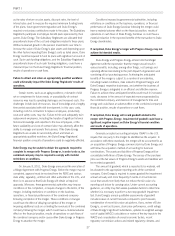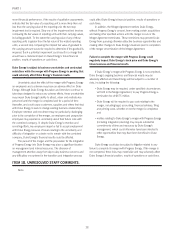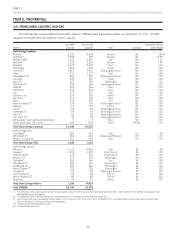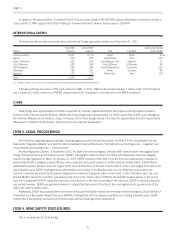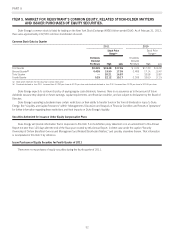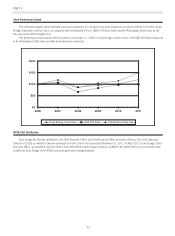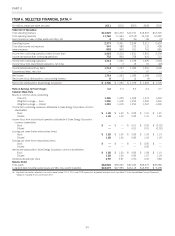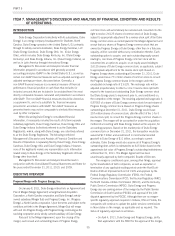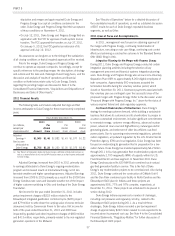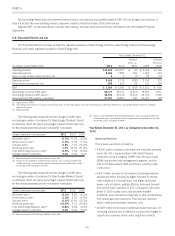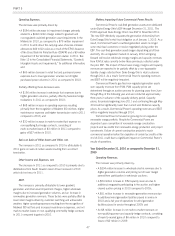Duke Energy 2011 Annual Report Download - page 57
Download and view the complete annual report
Please find page 57 of the 2011 Duke Energy annual report below. You can navigate through the pages in the report by either clicking on the pages listed below, or by using the keyword search tool below to find specific information within the annual report.
PART II
stipulation and merger and again required Duke Energy and
Progress Energy to accept all conditions contained in the
order. Duke Energy and Progress Energy filed their acceptance
of those conditions on November 4, 2011.
• On July 12, 2011, Duke Energy and Progress Energy filed an
application with the FCC for approval of radio system license
transfers. The FCC approved the transfers on July 27, 2011.
On January 5, 2012, the FCC granted an extension of its
approval until July 12, 2012.
No assurances can be given as to the timing of the satisfaction
of all closing conditions or that all required approvals will be received.
Prior to the merger, Duke Energy and Progress Energy will
continue to operate as separate companies. Accordingly, except for
specific references to the pending merger, the descriptions of strategy
and outlook and the risks and challenges Duke Energy faces, and the
discussion and analysis of results of operations and financial
condition set forth below relate solely to Duke Energy. Details
regarding the pending merger are discussed in Note 2 to the
Consolidated Financial Statements, “Acquisitions and Dispositions of
Businesses and Sales of Other Assets.”
2011 Financial Results.
The following table summarizes Adjusted Earnings and Net
income attributable to Duke Energy for three most recently completed
years.
Years Ended December 31,
2011 2010 2009
(in millions,
except per
share amounts) Amount
Per
diluted
share Amount
Per
diluted
share Amount
Per
diluted
share
Adjusted
Earnings(a) $1,943 $1.46 $1,882 $1.43 $1,577 $1.22
Net income
attributable to
Duke Energy $1,706 $1.28 $1,320 $1.00 $1,075 $0.83
(a) See ‘Results of Operations below for Duke Energy’s definition of Adjusted Earnings as
well as a reconciliation of this non-GAAP financial measure to Net income attributable
to Duke Energy.
Adjusted Earnings increased from 2010 to 2011 primarily due
to earnings attributable to Duke Energy’s ongoing modernization
program and increased results at International Energy net of less
favorable weather and higher operating expenses. Adjusted Earnings
increased from 2009 to 2010 primarily as a result of the 2009 Duke
Energy Carolinas rate cases and favorable weather net of the impact
of higher customer switching in Ohio and funding of the Duke Energy
Foundation.
Net income for the year ended December 31, 2011 includes
pretax impairment charges of $222 million related to the
Edwardsport integrated gasification combined cycle (IGCC) project
and $79 million to write down the carrying value of excess emission
allowances held by Commercial Power to fair value. Net income for
both of the years ended December 31, 2010 and 2009 was
impacted by goodwill and other impairment charges of $660 million
and $413 million, respectively, primarily related to the non-regulated
generation operations in the Midwest.
See “Results of Operations” below for a detailed discussion of
the consolidated results of operations, as well as a detailed discussion
of EBIT results for each of Duke Energy’s reportable business
segments, as well as Other.
2011 Areas of Focus and Accomplishments.
In 2011, management was focused on obtaining approval of
the merger with Progress Energy, continuing modernization of
infrastructure, executing on rate case filings, continuing cost control
efforts and achieving a constructive outcome to the Standard Service
Offer (SSO) filing in Ohio.
Integration Planning for the Merger with Progress Energy.
During 2011, Duke Energy and Progress Energy conducted certain
integration planning activities including the selection of key
management personnel and financial systems integration planning
work. Duke Energy and Progress Energy also announced a Voluntary
Separation Plan (VSP) to approximately 8,200 eligible employees of
both companies. Approximately 500 employees accepted the
termination benefits during the voluntary window period, which
closed on November 30, 2011. Severance payments associated with
this voluntary plan are contingent upon the successful close of the
proposed merger with Progress Energy. Refer to the discussion under
“Proposed Merger with Progress Energy, Inc.” above for the status of
various required federal and state regulatory approvals.
Continued Modernization of Infrastructure. Duke Energy’s
strategy for meeting customer demand, while building a sustainable
business that allows its customers and its shareholders to prosper in
a carbon-constrained environment, includes significant commitments
to renewable energy, customer energy efficiency, advanced nuclear
power, advanced clean-coal and high-efficiency natural gas electric
generating plants, and retirement of older less efficient coal-fired
power plants. Due to upcoming environmental regulations, potential
carbon legislation, air pollutant regulation by the U.S. Environmental
Protection Agency (EPA) and coal regulation, Duke Energy has been
focused on modernizing its generation fleet in preparation for a low
carbon future. Duke Energy has invested approximately $6.2 billion
through 2011 in four key generation fleet modernization projects with
approximately 2,700 megawatts (MW) of capacity within its U.S.
Franchised Electric and Gas segment. In November 2011 Duke
Energy Carolinas placed its 620 MW Buck combined cycle natural
gas-fired generation facility in service. This is the first of Duke
Energy’s key modernization projects to be commissioned. Also during
2011, Duke Energy continued the construction of Cliffside Unit 6
and the Dan River combined cycle facility in North Carolina and the
Edwardsport IGCC plant in Indiana and these projects are
approximately 95%, 77% and 97% complete, respectively, at
December 31, 2011. These projects are scheduled to be placed in
service during 2012.
Duke Energy Indiana experienced a number of challenges,
including cost pressures and regulatory scrutiny, related to the
Edwardsport IGCC project during 2011. As a result of these
challenges, Duke Energy Indiana recorded a pre-tax impairment
charge of approximately $222 million related to costs expected to be
incurred above its proposed cost cap. See Note 4 to the Consolidated
Financial Statements, “Regulatory Matters” for further discussion of
the Edwardsport IGCC project.
37


